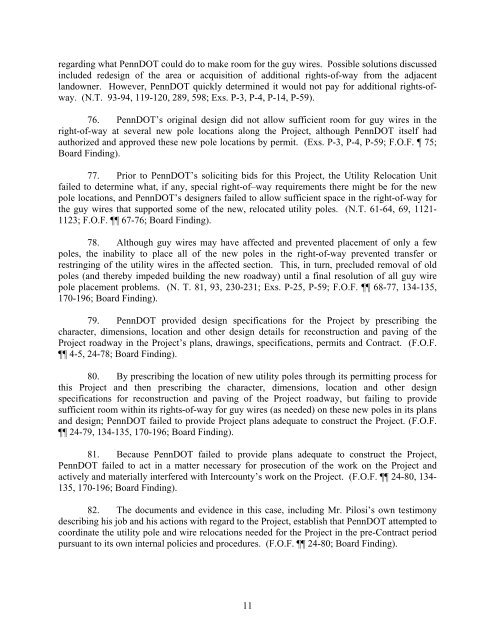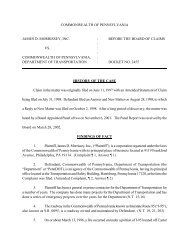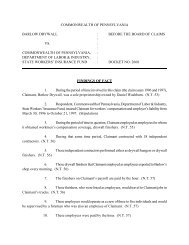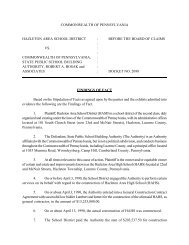3720 - Board of Claims
3720 - Board of Claims
3720 - Board of Claims
Create successful ePaper yourself
Turn your PDF publications into a flip-book with our unique Google optimized e-Paper software.
egarding what PennDOT could do to make room for the guy wires. Possible solutions discussed<br />
included redesign <strong>of</strong> the area or acquisition <strong>of</strong> additional rights-<strong>of</strong>-way from the adjacent<br />
landowner. However, PennDOT quickly determined it would not pay for additional rights-<strong>of</strong>way.<br />
(N.T. 93-94, 119-120, 289, 598; Exs. P-3, P-4, P-14, P-59).<br />
76. PennDOT’s original design did not allow sufficient room for guy wires in the<br />
right-<strong>of</strong>-way at several new pole locations along the Project, although PennDOT itself had<br />
authorized and approved these new pole locations by permit. (Exs. P-3, P-4, P-59; F.O.F. 75;<br />
<strong>Board</strong> Finding).<br />
77. Prior to PennDOT’s soliciting bids for this Project, the Utility Relocation Unit<br />
failed to determine what, if any, special right-<strong>of</strong>–way requirements there might be for the new<br />
pole locations, and PennDOT’s designers failed to allow sufficient space in the right-<strong>of</strong>-way for<br />
the guy wires that supported some <strong>of</strong> the new, relocated utility poles. (N.T. 61-64, 69, 1121-<br />
1123; F.O.F. 67-76; <strong>Board</strong> Finding).<br />
78. Although guy wires may have affected and prevented placement <strong>of</strong> only a few<br />
poles, the inability to place all <strong>of</strong> the new poles in the right-<strong>of</strong>-way prevented transfer or<br />
restringing <strong>of</strong> the utility wires in the affected section. This, in turn, precluded removal <strong>of</strong> old<br />
poles (and thereby impeded building the new roadway) until a final resolution <strong>of</strong> all guy wire<br />
pole placement problems. (N. T. 81, 93, 230-231; Exs. P-25, P-59; F.O.F. 68-77, 134-135,<br />
170-196; <strong>Board</strong> Finding).<br />
79. PennDOT provided design specifications for the Project by prescribing the<br />
character, dimensions, location and other design details for reconstruction and paving <strong>of</strong> the<br />
Project roadway in the Project’s plans, drawings, specifications, permits and Contract. (F.O.F.<br />
4-5, 24-78; <strong>Board</strong> Finding).<br />
80. By prescribing the location <strong>of</strong> new utility poles through its permitting process for<br />
this Project and then prescribing the character, dimensions, location and other design<br />
specifications for reconstruction and paving <strong>of</strong> the Project roadway, but failing to provide<br />
sufficient room within its rights-<strong>of</strong>-way for guy wires (as needed) on these new poles in its plans<br />
and design; PennDOT failed to provide Project plans adequate to construct the Project. (F.O.F.<br />
24-79, 134-135, 170-196; <strong>Board</strong> Finding).<br />
81. Because PennDOT failed to provide plans adequate to construct the Project,<br />
PennDOT failed to act in a matter necessary for prosecution <strong>of</strong> the work on the Project and<br />
actively and materially interfered with Intercounty’s work on the Project. (F.O.F. 24-80, 134-<br />
135, 170-196; <strong>Board</strong> Finding).<br />
82. The documents and evidence in this case, including Mr. Pilosi’s own testimony<br />
describing his job and his actions with regard to the Project, establish that PennDOT attempted to<br />
coordinate the utility pole and wire relocations needed for the Project in the pre-Contract period<br />
pursuant to its own internal policies and procedures. (F.O.F. 24-80; <strong>Board</strong> Finding).<br />
11






